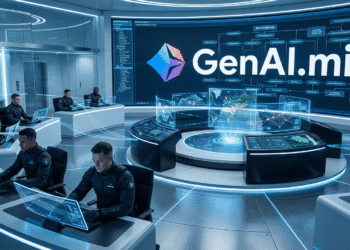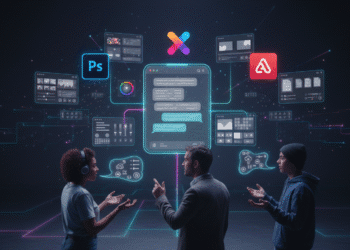
Bill Gates AI predictions. This time, he’s making bold claims about artificial intelligence (AI). According to Gates, AI will dramatically change two of society’s cornerstones—healthcare and education—within the next decade. Many experts and industry watchers are listening intently. They understand that when the Microsoft co-founder speaks, the technology world pays attention.
He has always had a gift for predicting the future of tech. From championing personal computers to foreseeing the rise of internet connectivity, he has usually been on the mark. Now, his latest vision suggests that AI is on the brink of reshaping how doctors diagnose illnesses and how teachers instruct students.
The implications are huge. AI could speed up patient care. It could also streamline lesson plans. Gates believes this change will be “very profound” and even admits it’s “a bit scary.” That concern resonates with many. Innovations can be unsettling. The promise and peril of advanced technology always seem to go hand in hand.
His recent statements—featured in TechTimes, Medium, and Wall Street Pit—highlight the urgency of adaptation. As the conversation intensifies, so does curiosity about what this seismic AI shift might look like in everyday life. For now, one thing seems certain. The next 10 years could be unlike any we’ve seen before.
Bill Gates’ Vision
Bill Gates has always envisioned technology as a tool to empower. From early software innovations to global philanthropic initiatives, he has championed innovation that benefits humanity. His current perspective on AI feels like a natural extension of that mindset. He sees AI as the next big leap, on par with the arrival of personal computers and the internet era. But this leap, he warns, won’t be a simple hop. It might be more like a catapult.
According to Gates, in just 10 years, AI might perform many of the critical tasks currently handled by physicians and educators. Why? Because algorithms can sift through enormous data sets much faster than humans. They can identify patterns in patient symptoms or learning styles with remarkable speed. In medicine, a faster diagnosis could mean a faster recovery. In the classroom, a more personalized lesson plan could mean a more engaged student.
Yet, Gates also highlights the fear factor. AI can be unsettling. Concerns about job loss, privacy, and fairness emerge whenever technology makes a disruptive leap. Gates acknowledges the “profound” scope of these transformations. He doesn’t shy away from words like “scary,” but insists that preparedness can turn potential nightmares into real benefits. In his view, it’s a matter of guiding AI rather than letting it run amok.
AI in Healthcare

Imagine a world where you walk into a clinic, and an AI system quickly scans your vital signs. It compares these metrics to millions of other patient records. Within seconds, it suggests a diagnosis and proposes a treatment plan. That’s not science fiction. According to Bill Gates and many researchers, it’s a forthcoming reality.
Today, AI already assists with tasks like radiology image analysis and patient data management. Medical professionals can use advanced tools to spot anomalies or track disease progression more efficiently. In the next 10 years, Gates predicts these systems will go even further. AI might help detect rare diseases early. It could also tailor medicine dosages based on genetic and lifestyle factors. That level of personalization could redefine healthcare standards around the globe.
But the prospect of AI-driven care raises questions. Will it sideline doctors? Can the human touch in medicine be replicated by algorithms? Gates suggests that the best outcome is a partnership. Doctors, nurses, and hospital staff would collaborate with AI to offer more precise, swift, and cost-effective care. Machines handle the data. Humans handle the empathy. This synergy could improve patient outcomes and ease the burden on overwhelmed healthcare systems. It might also lead to more consistent treatment, even in regions where specialist care is scarce.
AI in Education

Education is another sector on the cusp of transformation. Bill Gates envisions AI-driven platforms that adapt to each student’s learning pace, style, and interests. Picture a digital tutor that never tires of explaining algebra step by step, offering fresh examples every time you stumble. The same tutor could switch gears to help with reading comprehension, historical analysis, or any other subject. This personalized approach might reshape the classroom environment entirely.
In many countries, teacher shortages and overcrowded classrooms create serious challenges. AI could help by handling routine tasks, freeing teachers to focus on deeper engagement. Lesson planning might also become more data-driven. If an AI system notices a pattern—like multiple students misunderstanding a concept—it can alert the teacher in real time. Then, educators can adjust their methods or provide extra support before confusion grows.
Yet the idea of AI “replacing” teachers unsettles many. Gates acknowledges that concern, highlighting the importance of striking a balance. He doesn’t foresee a world with no human instructors. Rather, he sees educators evolving into facilitators, guiding AI-rich discussions and focusing on critical thinking skills. Students would benefit from a blend of consistent AI feedback and human mentoring. The result? Potentially higher test scores, improved attendance, and a more inclusive learning environment where no child falls through the cracks.
Potential Risks and Ethical Concerns
Every great leap in technology triggers a wave of questions. AI is no exception. Bill Gates’ predictions spark excitement, but also anxiety. One big worry is job displacement. If AI can handle diagnoses, what happens to junior doctors? If AI can teach math, what happens to new teachers? Some experts say these roles won’t vanish. Instead, they might shift toward tasks requiring empathy, creativity, and interpersonal skills.
Data privacy is another sticking point. AI thrives on information. In healthcare, that means patient records. In education, it means student performance data. Without robust regulations, sensitive details could leak or be used inappropriately. Gates emphasizes the need for responsible stewardship of information. Organizations must comply with privacy laws and ethical standards, or risk public trust.
Bias in AI systems is also a real concern. Algorithms can inadvertently amplify prejudices if they rely on skewed data. For example, if a medical AI was trained mostly on data from one demographic, it might misdiagnose another group. The same could happen with educational recommendations. Gates has been vocal about fairness in tech. He stresses that diverse data sets and transparent oversight processes are key. By ensuring that AI systems are carefully audited, society can reap the benefits without sacrificing equity or accuracy.
Bridging Gaps and Implementation
For AI to truly transform healthcare and education, we need more than advanced algorithms. We need improved infrastructure, widespread internet access, and robust training programs. Bill Gates often speaks about the digital divide. Many communities still lack basic internet services. In those areas, AI can’t gain traction. To make AI-driven medicine or AI-guided lessons available, governments and private entities must step up. They need to fund broadband expansions and develop user-friendly platforms.
Cost is another significant barrier. Cutting-edge technology can be expensive, at least initially. Hospitals might hesitate to invest in unproven AI tools. Schools might struggle to afford the newest devices. Gates, through his philanthropic efforts, has advocated for cost-effective solutions. He believes that over time, scaling AI will reduce expenses as more organizations adopt it. Early adopters might face steep costs, but eventually, economies of scale could make advanced AI platforms more affordable.
There’s also the question of training. Medical professionals need to understand how to interpret AI-generated reports. Teachers need to navigate AI-based lesson plans. This requires updated curricula in medical schools and teacher colleges. It’s not enough to introduce technology; people must learn how to use it responsibly and effectively. Gates foresees a global shift in educational programs that emphasize digital literacy, algorithmic thinking, and ethical guidelines for AI deployment.
Conclusion and Final Thoughts

Bill Gates sees a future rushing toward us. AI promises improved efficiency in hospitals and more dynamic learning in classrooms. It may reduce errors, personalize experiences, and spark new innovations. Yet, it also raises questions about data privacy, fairness, and job security. Gates calls it “profound” and admits it’s “a bit scary.” But he’s equally adamant that we must harness AI’s potential with wisdom, collaboration, and regulation.
His vision isn’t a doomsday scenario. It’s more of a clarion call for proactive involvement. Policymakers, tech developers, educators, and healthcare providers must align. They must guide AI toward humane and equitable goals. The next decade will be pivotal. How we adapt now might shape countless lives for generations to come.










Comments 1